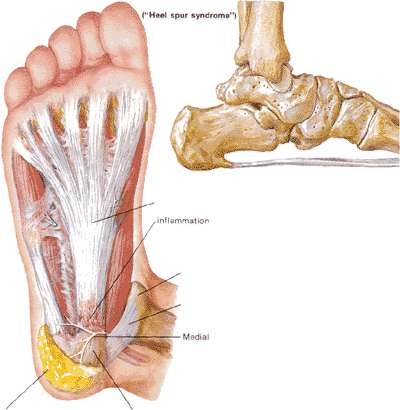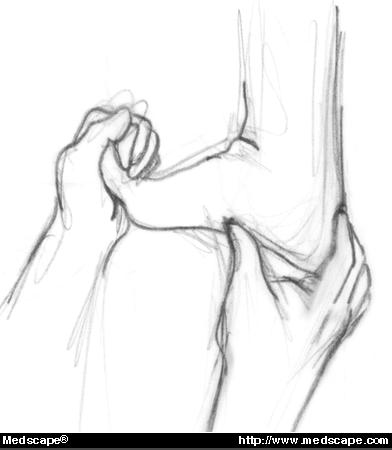Plantar
Fasciitis, The Plantar Fascia & Heel Spurs:
Heal that Heel
Plantar Fasciitis, the Plantar Fascia, & The
Plantar Fasciitis Test
Plantar Fasciitis, a common cause of heel pain
in adults, causes repeated episodes of pain in the heel that
sometimes extends to the sole of the foot. These painful bouts
often occur after times of increased activity, even light
activity, such as walking. Although the pain is usually
"self-limiting" (it tends to go away even without medical
treatment) it is commonly recurrent (meaning that the pain the
pain usually returns again).

Plantar Fasciitis is due to chronic tearing or
"stress failure" of the plantar fascia(Link to
stress failure of soft tissue). The plantar fascia is a band of
tissue that originates from the heel bone (calcneous)
and extends forward along the bottom of the foot, ending at
the toes. All feet have a plantar fascia and you can feel your
own by pulling your toes and foot back towards your knee as in
figure1. With your foot in this position, you can
easily feel the cord-like fascia that runs along the bottom of
your foot. If you then let your toes and foot relax you will
no longer be able to feel your plantar fascia. . Plantar Fasciitis often arises in patients who have an
abnormally shortened or tight plantar fascia.

Figure 1 Plantar Fascia Test
The maneuver described in the preceding paragraph is a
good test to diagnose plantar fasciitis. Patients
with plantar fasciitis have much more tenderness in
their plantar fascia when it is stretched (fig. 1) and much
less tenderness when the fascia is relaxed. The plantar
fasciitis test uses this property to help diagnose
patients with plantar fasciitis. To perform this test, first
stretch your plantar fascia as describe above, and
shown in figure 1. Then use your thumb or finger to
feel the plantar fascia. If your plantar fascia is
tender, then try the same maneuver with your plantar
fascia relaxed (let your toes and foot assume a relaxed
position). If pushing on the stretched plantar fascia causes more tenderness than pushing on the relaxed plantar fascia, then we believe that the plantar fascia
is likely the source of the pain and we say you have plantar fasciitis.
Why Would my
Plantar Fascia be Tight???
Origin
of the Tight Plantar Fascia
The plantar fascia often tightens as we age for
two main reasons. First, older adults are often less active
than children or younger adults. Inactive people spend more
time with there plantar fascia relaxed, while active people
spend more time with their plantar fascia in a stretched
position. Spending time with your plantar fascia in a
stretched position causes it to lengthen and therefore loosen
(have less internal tension for any given length). Conversely,
inactivity leads to a shorter and thus tighter plantar
fascia.
The plantar fascia is made of a protein called
"collagen". The second reason that our plantar fascia becomes
tighter with age is due to the difference in collagen
chemistry between older and younger people. With age collagen becomes less elastic, and therefore more prone
to tearing. A similar mechanism causes skin to wrinkle with
age. The reduced activity of many adults and the differences
in collagen chemistry between children and adults, causes a
tendency of the plantar fascia to become shorter, tighter, and
more prone to tearing with age.
A
Tight Fascia Becomes a Torn Fascia
As mentioned, aging tends to leave our plantar fascia less elastic and inactivity causes it to tighten
and shorten. Once your planter fascia is short and inelastic
it tears easily. Even simple walking subjects the plantar
fascia to repeated stresses. In the abnormally tight and
shortened plantar fascia, the stress of walking can easily
cause it to develop a small tear. Once a tear has started it
will enlarge with each step you take and a painful plantar
fascia develops. [see stress failure of soft tissue] The plantar fascia usually develops tears close to
where it originates at the calcaneous and less often in
the body of the plantar fascia.
The downward spiral of plantar
fasciitis
As a small tear develops in the plantar fascia, the
foot becomes painful and two things happen. First the foot
pain causes patients to become less active to decrease their
pain. Second, patients with a painful plantar fascia tend to
hold their foot in the relaxed position. This position puts
less force across the torn fascia and therefore the foot hurts
less in this position. With time, even without treatment, the
tear heals and the pain goes away. But keeping your foot in
the relaxed position results in the plantar fascia healing slightly shorter and tighter than it was before the
injury. When the fascia fully heals it is more prone to
re-tear during the next excursion to the mall. Since a tight plantar fascia is more prone to tearing than a loose plantar fascia and since the plantar fascia heals in a slightly shortened position after each injury, the
painful episodes become more frequent and require less
activity to develop. Eventually, a patient seeks medical
advice for the recurrent foot pain.
Many medical practitioners believe plantar fasciitis is
due to "inflammation"((link to
inflammation as a diagnosis) of the
plantar fascia. These practitioners will often give the
following recommendations.
a) Rest
b) Anti-inflammatory medication
(NSAIDs)
c) Heel-cup
d) Cortisone injections
e) Modality oriented Physical
therapy.
Since plantar fasciitis tends to improve with rest
alone, the above treatment will reduce the patient?s pain
leading both patient and physician to conclude that the
treatment was successful. Although the treatment outlined
above will allow the fascia to heal and the pain to subside,
the time resting without stretching will result in a slightly
tighter plantar fascia at the end of the treatment. Thus the
patient has an increased risk of recurrence, especially when
they increase their activity. This downward spiral of pain,
rest, shortening, and recurrence continues and patients will
often receive multiple treatments for painful plantar
fasciitis, each apparently successful, yet each not breaking
the downward spiral.
If the patient sees a clinician familiar with the
"tension theory of plantar fasciitis" they typically
receive the following treatment:
- Plantar fascia stretching
As the plantar fascia heals, it heals in a
lengthier position due to the stretching and is less prone to
repeated painful episodes. The downward spiral is
broken.
Heel Spurs
In the past many patients with heel pain were told they
had heel spurs. The diagnosis of heel spurs seemed logical. Foot x-rays of these patients would show a
spur rising from the bone at the site of the pain. Surgical
removal of the spur resulted in relief of the pain. Thus, heel spurs gained a reputation as a common cause of
foot pain, a concept that often persists today.
Fortunately, a less invasive operation has been
developed. Equally good results can also be achieved without
removing any bone. Simply cutting the plantar fascia through a small incision in the foot, and leaving even large heel spurs produces equal results to operable excision
of the heel spur. In fact, heel spurs do not
cause pain. A tight plantar fascia is the cause of plantar fasciitis and the heel spur is inconsequential.
Return to Dr. Cohen's Main Page
Return to Top |

